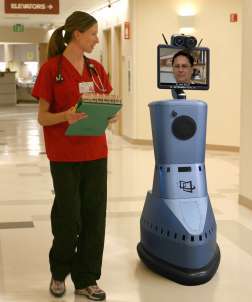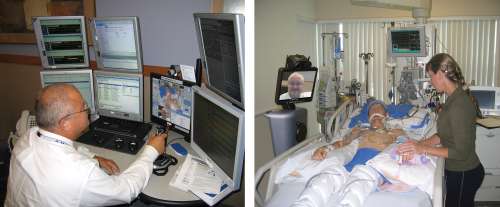| Information technology | |
Roaming robots give doctors remote access to hospital patients 24/729 November 2006 The Methodist Hospital in Houston, Texas has two robots that can be controlled remotely by a doctor to navigate wards and communicate with patients and staff on wards where rapid access to expert advice is critical.
From a remote location, even from home, a physician uses a laptop and joystick to guide the robot to the patient’s bedside, review medical chart information and speak with patients and nurses. Through a widescreen, two-way TV monitor, the doctor communicates with the patient and nurse face to face to determine the appropriate and immediate care needed. The ability to address patient care on a moment’s notice is especially helpful for treating acute stroke patients. The Methodist Hospital’s neurosurgical-ICU (NICU) and Eddy Scurlock Stroke Center are using the robots to help provide 24/7 coverage for patients, giving them immediate access to a physician. The Remote Presence technology is part of a larger patient safety and quality initiative within The Methodist Hospital System.
“Having the ability to see our patients and the ICU nursing staff and talk with them face to face when we can’t be there in person greatly impacts how we’re able to provide individualized treatment,“ said Dr. Saleem Zaidi, neuro-intensivist director in Methodist’s NICU. “Our window of opportunity for effective treatment is within three hours of the onset of stroke symptoms. This robotic technology gives us quicker access to the patients, and timeliness is everything in helping a stroke patient recover,” said Dr. David Chiu, medical director of the Eddy Scurlock Stroke Center. The robots do not replace physicians seeing patients in person. Instead, they supplement physician visits for those times when they cannot be present, especially during the overnight shifts. Methodist hopes to expand this robotic technology to other locations within the hospital and throughout the Methodist System. The robots are made by Santa Barbara, California-based InTouch Health. Methodist Hospital received a major grant from the William Randolph Hearst Foundation for this robotic technology.
|
 The
blue and black robots, nicknamed MURDOC (Mobile Unit Robot Doctor) and ROHAS
(Remote Operated Health Assessment System), travel up to 2 mph, can be
easily steered down a hallway or alongside a patient bed, and are equipped
with infrared sensors to help the physician navigate. The robots allow
physicians, patients, nurses and other staff to “virtually” interact and
talk at a moment’s notice.
The
blue and black robots, nicknamed MURDOC (Mobile Unit Robot Doctor) and ROHAS
(Remote Operated Health Assessment System), travel up to 2 mph, can be
easily steered down a hallway or alongside a patient bed, and are equipped
with infrared sensors to help the physician navigate. The robots allow
physicians, patients, nurses and other staff to “virtually” interact and
talk at a moment’s notice.